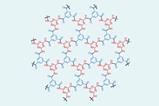A new metal–organic framework (MOF) selectively adsorbs two molecules of carbon monoxide at each metal site. The US-based researchers that developed it believe that the underlying chemistry may enable the design of MOFs that capture other gases with greater efficacy.
MOFs were the focus of this year’s Nobel prize in chemistry due to their ability to bind specific molecules, which makes them particularly useful for storage and filtration. In the vast majority of MOFs, each site in the framework can adsorb a maximum of one target molecule.
However, some very rare examples show ‘co-operative adsorption’. ‘There are some examples … when one molecule would be adsorbed it would undergo a chemical reaction that made it easier for the second and even easier for the third,’ explains synthetic inorganic chemist Kurtis Carsch at the University of Texas at Austin. However, the design principles behind these MOFs are difficult to generalise for the adsorption of other molecules.
In the new work, Carsch and colleagues led by Jeffrey Long at the University of California, Berkeley, synthesised CoMe-MFU-4l, a MOF that contains cobalt(II)–methyl sites. At ambient temperature and partial pressure of just 10 millibars, the structure adsorbed around 1.6 times more carbon monoxide than if every single site were occupied by one molecule. It was also extremely selective, requiring much higher pressures to adsorb other gases. The adsorption was reversible under vacuum, and the material retained 98% of its activity after 50 cycles.
The researchers’ analysis suggests that adsorption of one carbon monoxide molecule triggers a spin transition in the cobalt ion. This facilitates the insertion of a second carbon monoxide molecule between the cobalt and the methyl group. The process does not require the involvement of any other bonding sites in the MOF. ‘The Long group are thinking of other opportunities for very different gases that can bind to a site,’ says Carsch, ‘Can you have multiple oxygen atoms? Can you have multiple acetylene molecules?’
The researchers are also looking at uses for the material in applications such as hydrogen purification. ‘A lot of fuel cells, which use hydrogen, will be irreversibly poisoned by carbon dioxide,’ says Carsch. ‘These trailing decimals at parts per million levels can lead to complete deactivation of the catalyst.’
Chemical engineer Andrew Medford from the Georgia Institute of Technology in Atlanta, who helped develop the ODAC25 database exploring MOFs as potential carbon capture materials, is intrigued. He is surprised, he says, that a mechanism involving formation of a covalent bond is so readily reversible. ‘The thing that I think is most interesting from a computational screening standpoint is the role of spin,’ he says, adding that this is normally treated as a fixed property in MOFs. ‘On the one hand it points to things that could be missed even in the highest end high-throughput databases, but on the other hand it’s exciting because it means that if we do go through and really carefully check for spin-state optimisation, we could discover some of these exotic binding modes,’ he says.
References
K M Carsch et al, Science, 2025, DOI: 10.1126/science.ady2607









 User Center
User Center My Training Class
My Training Class Feedback
Feedback















Comments
Something to say?
Login or Sign up for free